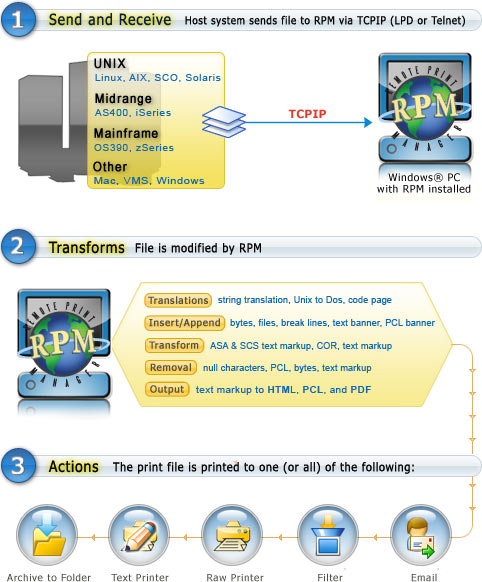RPM Remote Print Manager® ("RPM") is a print server that receives print files from systems such as AS/400, OS390, or any host system and mainframe. RPM loads on a Windows PC and manages your print job based on your predefined transforms and actions.

Print management features within RPM include control over fonts, margins, line wrap, printer setup, and various other print features sought by mainframe users, such as suppressing trailing blank pages and scaling down the font to support a given line length. With this type of print management, you have the flexibility to print data from across the world or from the mainframe down the hall. In addition, the new RPM 5.0 Select gives you the tools to print host data to PDF and HTML and email to one or multiple recipients any print file received from the mainframe or host system.
RPM Remote Print Manager Enhances Printing
- Easily configure RPM to fit text output to any size paper. RPM supports all fonts the printer can use. Also, a variety of host data formats enable end-users to print without host system modifications.
- RPM follows the established UNIX model of using named print queues to represent distinct processing requirements. Thus, each queue you create in RPM is fully configurable and independent from every other queue.
- Automatically create a print queue when a job is received, reducing network administration time by eliminating the need to search for misnamed queues.
- Users can easily select the appropriate code page to use when printing. In addition, RPM can use any code page currently installed on the PC.
- Extensive logging in RPM provides each message in an easy-to-read format. Each log message shows a unique RPM event number, the time, the source of the message, the application that generated the message, and the message text. You can configure RPM to log only a minimal amount of messages or high-detail messages.
- Easily translate and convert text from different formats. For example, translate EBCDIC data, ASA carriage control codes, convert SCS to ASCII, or EBCDIC to ASCII for all queue types. SCS formatting is preserved in text mode, including font changes and character positioning.